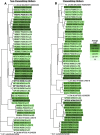Maternal Neutralization-Resistant Virus Variants Do Not Predict Infant HIV Infection Risk
- PMID: 26838723
- PMCID: PMC4742716
- DOI: 10.1128/mBio.02221-15
Maternal Neutralization-Resistant Virus Variants Do Not Predict Infant HIV Infection Risk
Abstract
Mother-to-child transmission (MTCT) of HIV provides a setting for studying immune correlates of protection. Neutralizing antibodies (NAbs) are suggested to contribute to a viral bottleneck during MTCT, but their role in blocking transmission is unclear, as studies comparing the NAb sensitivities of maternal viruses have yielded disparate results. We sought to determine whether transmitting mothers differ from nontransmitting mothers in the ability to neutralize individual autologous virus variants present at transmission. Ten transmitting and 10 nontransmitting HIV-infected mothers at high risk of MTCT were included in this study. Full-length HIV envelope genes (n = 100) were cloned from peripheral blood mononuclear cells obtained near transmission from transmitting mothers and at similar time points from nontransmitting mothers. Envelope clones were tested as pseudoviruses against contemporaneous, autologous maternal plasma in neutralization assays. The association between transmission and the log2 50% inhibitory concentration (IC50) for multiple virus variants per mother was estimated by using logistic regression with clustered standard errors. t tests were used to compare proportions of neutralization-resistant viruses. Overall, transmitting mothers had a median IC50 of 317 (interquartile range [IQR], 202 to 521), and nontransmitting mothers had a median IC50 of 243 (IQR, 95 to 594). Transmission risk was not significantly associated with autologous NAb activity (odds ratio, 1.25; P = 0.3). Compared to nontransmitting mothers, transmitting mothers had similar numbers of or fewer neutralization-resistant virus variants, depending on the IC50 neutralization resistance cutoff. In conclusion, HIV-infected mothers harbor mostly neutralization-sensitive viruses, although resistant variants were detected in both transmitting and nontransmitting mothers. These results suggest that MTCT during the breastfeeding period is not driven solely by the presence of maternal neutralization escape variants.
Importance: There are limited data demonstrating whether NAbs can prevent HIV transmission and infection in humans, and for this reason, NAbs have been studied in MTCT, where maternal antibodies are present at the time of transmission. Results of these studies have varied, perhaps because of differences in methods. Importantly, studies often used cultured viruses and samples from time points outside the window of transmission, which could confound findings. Here, we considered the role of maternal NAbs against individual maternal virus variants near the time of transmission. We found no evidence that NAbs are associated with protection from infection. In fact, depending on the cutoff used to define neutralization resistance, we found evidence that nontransmitting mothers have more neutralization-resistant virus variants. These results suggest that lack of virus transmission in the early breastfeeding period is not simply due to an absence of maternal neutralization escape variants and likely includes multiple factors.
Copyright © 2016 Milligan et al.
Figures


Similar articles
-
Maternal but Not Infant Anti-HIV-1 Neutralizing Antibody Response Associates with Enhanced Transmission and Infant Morbidity.mBio. 2017 Oct 24;8(5):e01373-17. doi: 10.1128/mBio.01373-17. mBio. 2017. PMID: 29066544 Free PMC article.
-
Maternal Broadly Neutralizing Antibodies Can Select for Neutralization-Resistant, Infant-Transmitted/Founder HIV Variants.mBio. 2020 Mar 10;11(2):e00176-20. doi: 10.1128/mBio.00176-20. mBio. 2020. PMID: 32156815 Free PMC article.
-
Mutations that confer resistance to broadly-neutralizing antibodies define HIV-1 variants of transmitting mothers from that of non-transmitting mothers.PLoS Pathog. 2021 Apr 2;17(4):e1009478. doi: 10.1371/journal.ppat.1009478. eCollection 2021 Apr. PLoS Pathog. 2021. PMID: 33798244 Free PMC article.
-
Antibodies for prevention of mother-to-child transmission of HIV-1.Curr Opin HIV AIDS. 2015 May;10(3):177-82. doi: 10.1097/COH.0000000000000150. Curr Opin HIV AIDS. 2015. PMID: 25700205 Free PMC article. Review.
-
Transmission of HIV-1 in the face of neutralizing antibodies.Curr HIV Res. 2007 Nov;5(6):578-87. doi: 10.2174/157016207782418461. Curr HIV Res. 2007. PMID: 18045114 Review.
Cited by
-
The Role of Maternal HIV Envelope-Specific Antibodies and Mother-to-Child Transmission Risk.Front Immunol. 2017 Sep 4;8:1091. doi: 10.3389/fimmu.2017.01091. eCollection 2017. Front Immunol. 2017. PMID: 28928750 Free PMC article. Review.
-
Infant transmitted/founder HIV-1 viruses from peripartum transmission are neutralization resistant to paired maternal plasma.PLoS Pathog. 2018 Apr 19;14(4):e1006944. doi: 10.1371/journal.ppat.1006944. eCollection 2018 Apr. PLoS Pathog. 2018. PMID: 29672607 Free PMC article.
-
Maternal but Not Infant Anti-HIV-1 Neutralizing Antibody Response Associates with Enhanced Transmission and Infant Morbidity.mBio. 2017 Oct 24;8(5):e01373-17. doi: 10.1128/mBio.01373-17. mBio. 2017. PMID: 29066544 Free PMC article.
-
Vertical HIV-1 Transmission in the Setting of Maternal Broad and Potent Antibody Responses.J Virol. 2022 Jun 8;96(11):e0023122. doi: 10.1128/jvi.00231-22. Epub 2022 May 10. J Virol. 2022. PMID: 35536018 Free PMC article.
-
HIV-1 Subtype C-Infected Children with Exceptional Neutralization Breadth Exhibit Polyclonal Responses Targeting Known Epitopes.J Virol. 2018 Aug 16;92(17):e00878-18. doi: 10.1128/JVI.00878-18. Print 2018 Sep 1. J Virol. 2018. PMID: 29950423 Free PMC article.
References
Publication types
MeSH terms
Substances
Grants and funding
LinkOut - more resources
Full Text Sources
Other Literature Sources
Medical

